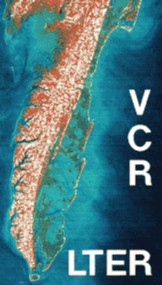 RELATIVE IMPORTANCE OF BACTERIA AND PHYTOPLANKTON TO HIGHER TROPHIC LEVELS IN AUTOTROPHIC AND HETEROTROPHIC ESTUARIES |

Takisha A. Cannon, Karen W. Wu, and Linda K. Blum
Laboratory of Microbial Ecology
|
 RELATIVE IMPORTANCE OF BACTERIA AND PHYTOPLANKTON TO HIGHER TROPHIC LEVELS IN AUTOTROPHIC AND HETEROTROPHIC ESTUARIES |

Takisha A. Cannon, Karen W. Wu, and Linda K. Blum
Laboratory of Microbial Ecology
|
The relative importance of phytoplankton and bacteria to consumers was compared in tidal creeks of the lower Delmarva Peninsula. Creeks on the Chesapeake Bay side (bayside) of the peninsula are autotrophic (primary production > respiration) while creeks of the VCR LTER coastal lagoons are heterotrophic (respiration > primary production). Grazing of bacteria and phytoplankton were measured using a dilution technique (Landry and Hassett 1984). Bacterial standing stock was measured using acridine orange direct counts (Hobbie et al. 1977) and cell biovolume frequency distributions were determined as described in MacMillin et al. (1992). Bacterial biomass was estimated from biovolume measurements assuming a conversion factor of 0.354 pg C mm3. Bacterial productivity was determined by tritiated thymidine incorporation (Moriarty and Pollard 1984). Phytoplankton standing stock was measured as chlorophyll-a concentration (Jonas and Tuttle 1990) and production as 14CO2 incorporation. Additional measures included heterotrophic nanoflagellate abundance, temperature, salinity, dissolved O2, dissolved inorganic nitrogen and phosphorous, total suspended solids, particulate organic matter, dissolved organic matter, and Secchi depth.
Bacterial abundance and biomass were both significantly greater in the autotrophic bayside waters, but bacterial standing stock turnover times were significantly slower than in the heterotrophic seaside waters. Bacterial production was highly variable in both systems so that there were no detectable differences between the estuaries. Grazing constants for consumption of bacteria were consistently higher in the heterotrophic than in the autotrophic creeks (Fig. 1), but grazing rates (grazing constant x standing stock) were similar as a result of differences in bacterial abundance. In the heterotrophic seaside creeks, bacterial production and grazing rates were balanced while bacterial production greatly exceeded grazing in the autotrophic bayside waters (Fig. 2).
Phytoplankton standing stocks were also consistently greater in the
autotrophic system than in the heterotrophic creeks. Production in the autotrophic
bayside was twice that for the heterotrophic seaside in spring and early
summer. Measurable grazing of phytoplankton was only observed in the bayside
creek. We were unable to detect any grazing in the seaside creek. These
results suggest that in the autotrophic, bayside creek little of the bacterial
carbon leaves the microbial loop, but that microbially-based food webs may
be important in the heterotrophic, seaside waters where phytoplankton production
is low and allochthonous sources of dissolved organic carbon are available
to the bacteria.